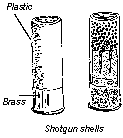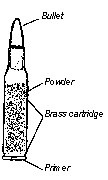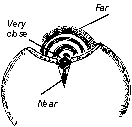Guns
|
Guns have been a part of the lives of Alaskans for many generations. Previous to the development of rifles, shotguns, and handguns, people used bows, snares, harpoons, and traps. The advent of guns changed the lives of Alaskans as new techniques for hunting were developed. Harvesting game became easier than before. Guns were very important trade items in the early days of contact with the Western world. A gun is a very personal item to most people living in remote areas. A quick look at the guns in a village shows that there are many different makes and models all designed for different applications. Some of the differences are important and some are the result of personal preferences. If we hunt caribou with the same rifle that we hunt ptarmigan, there will be problems. Either the caribou will escape wounded, or the ptarmigan will be blown to a pile of feathers, depending on the direction of our error. |
|||
|
Three Types of GunsThere are basically three types of guns: Rifles usually have a barrel over eighteen inches and have “rifles” (grooves) inside the barrel. They are most often used on animals rather than birds. They shoot bullets one at a time for long distances with great accuracy. Shotguns shoot round lead or steel balls of varying sizes. We use shotguns mostly on birds. As birds are often flying fast or sitting low in the water, they are hard to hit with only one bullet. A shotgun throws many smaller lead or steel pellets at the birds, increasing the hunter’s chances of hitting them. While they are quite effective up close, they don’t shoot far at all. Handguns are seldom used for hunting. They don’t have as much power as most rifles and aren’t very accurate for long distances. Handguns are much easier to carry which is why so many Alaskans use them for protection against bears and wolves. They are also used to kill large animals still alive in traps, such as wolves, lynx, and wolverine. |
||
CartridgesCartridges are made of several different parts:
|
|||
|
Mushroomed bullet increases surface area and damage |
The BulletThe lead bullets are large and small, hard and soft, naked and jacketed, pointed and blunt. They all have different applications. Size. If a bullet is too large it will destroy the meat, like shooting a ptarmigan with a 180 grain .30-06 bullet. If it is too small, it will not do enough damage and will only wound the animal. For that reason, it is against the law to shoot a moose or caribou with a .22. The diameter of the bullet is referred to as the caliber. A .22 caliber is smaller than .30 caliber which is smaller than .50 caliber. Bullets are weighed in grains. A .22 is commonly 55 grains. A .30–06 might be 120, 150, 180, or 220 grains. Different shapes make bullets hard to estimate the weight. Accurate measurement is important. Hard and Soft If a bullet is too hard, it will go through an animal without doing enough damage to knock it down. The animal might escape wounded. If the bullet is too soft, it will spread out (mushroom) on impact, and will not penetrate deep enough to reach vital organs. Again, the result is a wounded animal. The bullet that is right for the animal will mushroom on impact, and still penetrate to do the most damage in the internal organs. Naked and Jacketed The rate at which a bullet mushrooms on impact is controlled by a copper jacket around the soft lead. A naked lead bullet will splatter too easily if it hits big bones. A completely jacketed bullet will not mushroom at all if it doesn’t encounter resistance in the animal. A .22 caliber bullet is not jacketed, but is covered with a wax to minimize friction as the bullet is driven down the barrel. Without the wax, too much lead would deposit inside the barrel. If the bullet is pointed, it will have a minimum of wind resistance, traveling farther and faster, but will be easily deflected. If the bullet is blunt, it will encounter considerable wind resistance, reducing the impact at a distance, but it will go through small obstacles like brush and grass. [This view is commonly held, but everyone isn't in agreement] |
||
MaterialThe bullet is almost always made of lead. The high density of lead gives it the most force on impact of any reasonably priced metal. It is also soft enough to mushroom. Look at lead on the Periodic table. What is it’s atomic weight? Is it heavier than iron? The jacket around the lead is most often of copper. Copper is harder than lead, holding it together for slower mushrooming. Copper also provides low friction going cleanly down the barrel of the rifle. Shotgun pellets used for hunting waterfowl are now made of steel. It was determined that waterfowl were eating the lead pellets, poisoning themselves. Steel is less dense than lead, with less ability to bring a bird down. Hunters compensate for this by using one size bigger BB shot. |
|||
The Perfect BulletIt is easy to see that the choice of bullets depends totally on which animal is being hunted under what conditions. There is no perfect bullet or caliber. For hunting caribou at a distance, I use a pointed, lighter bullet that is rather soft. For hunting bears in the brush I use a heavy, blunt bullet. The goal is to effectively and safely harvest animals with no wounded animals escaping. I would rather miss an animal entirely than have it escape wounded. |
|||
|
|
PrimersPrimers are the small silver colored inserts in the center of the back of the cartridge (except .22s). They are like the caps in a child’s toy gun. When they are struck, pressure and friction within cause them to ignite. The primers have little power by themselves. They couldn’t drive the bullet out of the barrel. Their job is to ignite the powder which drives the bullet. Primers can only be used once and must be changed if the cartridge is reloaded. Reloading is inherently dangerous and should only be done under supervision by a trained adult. However, when done sensibly according to the directions, it provides a great savings and sense of satisfaction for the hunter. |
||
Chain ReactionHow can the little bit of energy we release, as we squeeze the trigger, cause such a noise and drive a bullet with so much force? Our pressure on the trigger releases the stored kinetic energy of the spring behind the firing pin. When this is released, it strikes and releases the stored chemical energy of the primer. The ignition of the primer releases the stored chemical energy of the powder. This creates high pressure gasses which push the bullet out of the barrel of the rifle. The bullet now has tremendous kinetic energy. Our pressure on the trigger releases a chain reaction that looses many forms of stored energy. A cartridge stores energy until the split second we need it. |
|||
PowderThere are a multitude of powders available. The greatest variables in loading different powders are: Quantity. Obviously, more powder will provide more power or impulse than less powder. The surface area of the powder helps to determine the rate of burn. The same amount of fine powder will burn faster than a like amount of coarse powder. Types. Different powders burn at different rates. This is most important. If the powder burns too slowly, the bullet will be out of the barrel before the powder is completely consumed. Energy is wasted. If the powder burns too fast, the powder will be burned before the bullet leaves the barrel. Rifle and Handgun Powder Rifle powder will not burn fast enough in a handgun. Handgun powder burns far too fast to be loaded in a rifle cartridge in the same quantity. Safety Old time Alaskans used to reload their own cartridges, but the lack of proper measuring devices caused many accidents that led people to prefer store-bought ammunition. Proper storage of powder also presented problems. Clean burning It is important that powder burns clean. A dirty barrel might explode when bullets force their way down a clogged barrel. Many chemical reactions will create the force necessary to drive a bullet down the barrel, however, modern powders burn quite cleanly. Oxygen or What? For years I wondered where the oxygen came from to burn the powder. Later it dawned on me that there is no oxygen. A quick look at the Periodic table of elements shows that sulfur is in the same group as oxygen. In old-time black powder, sulfur, a solid, takes the place of the large amounts of oxygen that would be required to efficiently oxidize (burn) the other elements in the powder. [Sulfur has two free valence electrons like oxygen.] In more modern powders, nitrates take the place of oxygen and sulfur in oxidizing the powder. |
|||

|
Brass CartridgeRifle and Handgun Most cartridges are made of brass. Brass is soft enough to slip in and out of the rifle’s chamber without causing a lot of wear by friction. When fired, the soft brass cartridge expands against the strong heavy steel of the firing chamber which holds it in shape. The cartridges of different calibers are unique. They have long and short necks, and bodies which are straight or tapered. A cartridge collection is fun and has rich history involved. Shotgun Shotgun cartridges have brass on the back end, but they are made mostly of plastic. The plastic protects and seals, keeping the cartridge dry. Within the plastic shotgun shell is a plastic cup called “wadding” that holds the pellets. When the primer ignites the powder, the cup and pellets are driven out of the barrel. When it hits the open air, the light plastic wadding slows down and the pellets are carried along their course by inertia. The cup provides very low friction for the pellets to get out of the barrel. Without it, the pellets would jam tightly in the barrel, greatly reducing velocity. Before plastic, a cotton wad separated the pellets and expanding powder. |
||
 |
RiflingA look down the barrel of most shotguns shows that the barrel is perfectly smooth. A shotgun’s pellets are thrown straight out of the barrel. A rifle is different. The word “rifle” actually means a groove. A look down the barrel of any rifle shows grooves that spiral the full length of the barrel. Early gunsmiths understood science very well. A round bullet that is shot out of a barrel with no spinning motion will wander terribly, making accuracy impossible. If a long slim bullet didn’t spin, it would tumble wildly in the air for a short distance. When a bullet is driven down a spirally grooved barrel, the spinning motion keeps the bullet from wandering. Once the bullet has rotational inertia, it resists changing it’s direction, just like a spinning top or football quarterback’s pass. Without the grooves (rifles), modern hunting wouldn’t be the same. Long distance shooting would be a matter of chance, rather than skill. |
||
Types of ActionsA rifle or shotgun can have five different types of actions, or ways, of getting the cartridge into the firing chamber. Single shot. This is the simplest action. The gun is opened, and the cartridge is inserted by hand. It is removed by hand after it is fired. Most young people are given a single shot .22 for their first gun as they are safe and simple. Bolt-action rifles are the safest, most reliable, and tend to be the most accurate. They aren’t the fastest to operate, as they require the hunter to take his/her eye off the target to reload. It is very easy to bore sight a bolt action rifle. This will be explained later. Bolt actions don’t seem to work as well for shotguns. Pump actions allow the hunter to continue to eject spent cartridges and insert new ones while his/her eye remains on the target. However, they aren’t as strong as a bolt and the sliding parts tend to slow down with friction if the gun is at all dirty. They also freeze easily in the winter. Pump-action shotguns have long been favorites for their speed over bolt action, and for reliability and safety over semiautomatics. We seldom use a shotgun in winter. Lever action is a reliable rifle action, but there are many moving parts and the cartridge isn’t locked in as safely as a bolt action. It is very difficult to bore sight a lever action. They have made their way into all of our hearts through Western movies. They are fast. The hunter can lever a cartridge into the chamber without dropping the rifle and taking his eye off the target. When they are working, semiautomatic weapons are amazingly fast. However, they are very sensitive to dirt and weather, and tend to malfunction much more than bolt, pump, or lever actions. They are also terribly dangerous. As soon as a bullet is fired, another is there in its place. The hunter must be very careful. |
|||
Handgun SafetyHeavy objects have greater inertia, or resistance to motion than light ones. Handguns, because they are lighter, can easily be pointed in different directions. They are far more dangerous than rifles for this reason. |
|||
|
Top cylinder
has
|
Handgun ActionsHandguns have two common actions. Revolvers usually hold six cartridges. They are slower than automatics but are totally reliable. Most wise hunters leave one cartridge out, keeping the hammer on the empty chamber so the handgun cannot be accidentally fired. This leaves five safe shots. Semiautomatic weapons can shoot faster than revolvers with greater ease of holding on the target. Their lack of reliability in Alaska’s harsh weather make them more dangerous than rifles. It would be interesting to discover whether there have been more hunters or bears shot with handguns. In the hands of a mature experienced person, they are useful, but the handgun hazard is often greater than the bear threat. |
||

|
RecoilOur first question about a gun is often, “How hard does it kick?” Obviously, a gun with more powder and a bigger bullet will have more recoil. Action equals reaction. When the bullet is forced out the barrel, the gun is forced backward. There are other factors that influence recoil. The mass of the gun makes a big difference. A light [light and heavy are in reference to mass] gun will “kick” considerably more than a heavier gun. For example, if you step out of a small boat onto a dock, the boat will be pushed away and you might fall in the water. If you step out of an oceanliner onto the dock, the force of your step is the same, but the mass of the oceanliner keeps it from moving away from the dock. In the same way, the lighter gun will move more in response to the bullet leaving the barrel than will a heavy one. A small person might be hurt by a light single shot 12 or 20 gauge shotgun. The same person might be able to shoot a heavier shotgun with less discomfort. Many guns have a soft rubber recoil pad. This absorbs much of the shock from the gun. Handguns kick rather hard because they are light and must force the bullet out of the barrel in a very short period of time. While a rifle isn’t gentle, it pushes the bullet more gradually and therefore kicks less sharply than a handgun. |
||
Bore SightingHunting seasons are getting shorter and shorter. There is little opportunity to make mistakes and still come home with meat. The hunter must be sure his rifle is sighted in properly. Automatics, pumps, and lever actions are difficult or impossible to bore sight. A bolt action has three distinct advantages here:
When bore-sighting, I usually look down the bottom of the barrel, although sighting down the middle of the barrel is almost as good. You are making sure that the line-of-sight of the barrel and line-of-sight of the sights are nearly parallel. Bore sighting gets a rifle close, but the hunter must shoot at a target and fine tune the sights as all bullets shoot differently.
|
|||
|
|
Sights vs. ScopesBefore scopes were available, open sights were the only choice. Open sights are good because:
The disadvantage of open sights are that the hunter’s eye is trying to focus in three places:
This is difficult enough for people who have good eyes and far more difficult for those who don’t. Scopes have become popular for several reasons:
Scopes have some distinct disadvantages:
Whatever a hunter chooses will be determined by the needs and applications. Shotguns don’t have scopes for hunting birds, nor do they have open sights. The shotgun needs to be an extension of the hunter’s body. It isn’t sighted. It is pointed. If the stock of the shotgun doesn’t fit the face and body of the hunter well, he/she will continually miss. The stock needs to be shaped until the place where the hunter is pointing the gun is the same place the eye is looking when the gun is at the shoulder. The importance of this cannot be overstated. In the Lower 48, deer and elk hunters put scopes on shotguns using one-ounce slugs. Slugs don’t travel as far as rifle bullets, which is important in highly populated areas. |
||
TrajectoryThe trajectory of a bullet is the path that it takes between the gun and the target. One bullet is dropped from a place 3’ from the ground. Another bullet is shot at the same time from a rifle barrel that is 3’ from the ground. The rifle barrel is perfectly parallel to the earth’s surface. Which bullet will hit the ground first? Most people say that the one that is dropped straight down will hit the ground first, but in theory, they both will hit the ground at the same time.[This is in theory. The curvature of the earth would cause the bullet that is shot to fall a greater distance.] The bullet that is shot will travel outward farther and faster, but gravity works downward on both of them identically.
Once a bullet leaves the barrel, it starts to drop. If we want to shoot a long way, we must aim above the target so the bullet will fall down into the target. Surprisingly, heavy bullets and light bullets fall at the same speed. A light bullet might travel faster, and get to the target sooner, therefore falling less, but a heavy bullet doesn’t fall faster than a light one. If we are shooting a short distance, we probably won’t have to raise the gun much at all. However, after 200 yards, the drop can be considerable. The hunter needs to know the rifle and the facts surrounding the trajectory of the different bullets. It may be necessary to aim six to ten inches above the target to hit it at a great distance. Some people have made a great study and hobby of guns. The rest of us use them to get meat from the woods to the table. Most important are hunter safety and not losing a wounded animal.
|
|||

|
Activities
|
||

|
Student Response
|
||

|
Math
|






